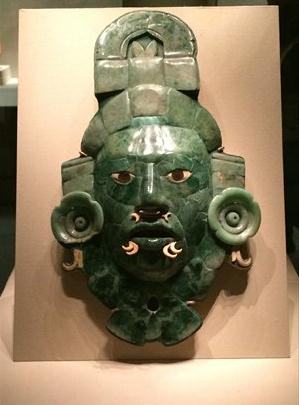

Jade funerary mask from Late Classic period (600-900) Photo: Xiong Yuqing/GT
Cultural coincidence
In 2007, 2005 Galaxy Award (Chinese highest award for science fiction) winner Ma Li (also known as Ma Boyong) published a novel The History of the Conquest of Maya, in which he told the fictional story of Chinese merchants during Shang Dynasty (C.1600-1046 BC) sailing to Mesoamerica and exploring the ancient Maya region. Not only is Ma a fan of Maya culture, some other Chinese authors, such as He Ma, who wrote The Tibet Code series, have also used Maya elements in their works.
Fiction aside, some Chinese scholars, including Wang Guowei and Guo Moruo, have proposed that there might be some connection between ancient China and the Maya empire.
Many similarities can be seen between the two ancient civilizations, for instance their love of jade, which was seen as a sacred and precious stone more valuable than gold.
"Some Maya people wore a jade mask after they died, as they believed jade could aid in the rebirth of life, while some Chinese royals in ancient times wore entire suites made of jade in their coffins," Ortiz Lanz explained. "We selected some of our prettiest jade masks and brought them to this exhibition, so that Chinese visitors would be able to see the essence Maya's ancient jade arts."
Other similarities have to do with the worship of mythical creatures. The Chinese dragon and the Maya Kukulkan were both creatures shaped like a snake, could fly and were associated with prayers for rain.
At the exhibition, visitors can also see imagery where the figurine of Ixchel, the Maya moon goddess, is accompanied by a rabbit, just like the ancient Chinese myth of Chang'e, who flew to the moon after ingesting her husband's potion of immortality.
Ortiz Lanz told the Global Times that currently there is no strong evidence showing that the Maya civilization came from Asia.
"There is also a similar line of thought in Mexican academic circles that some branch of Mexican civilization may have come from Asia, or even China. Some Asian migrant groups may have moved from the Asian continent through the Bering Strait 2,000 years ago, bringing their knowledge and culture with them.
"But all the research in this field is still in a preliminary stage. There are still many objects which might provide evidence that is buried in the sea. We hope that experts from China and Mexico will have more opportunities to cooperate and push this area of study," Ortiz Lanz told the Global Times.
Five tourists saved from Maya Snow Mountain in NW China
2014-07-21Copyright ©1999-2018
Chinanews.com. All rights reserved.
Reproduction in whole or in part without permission is prohibited.